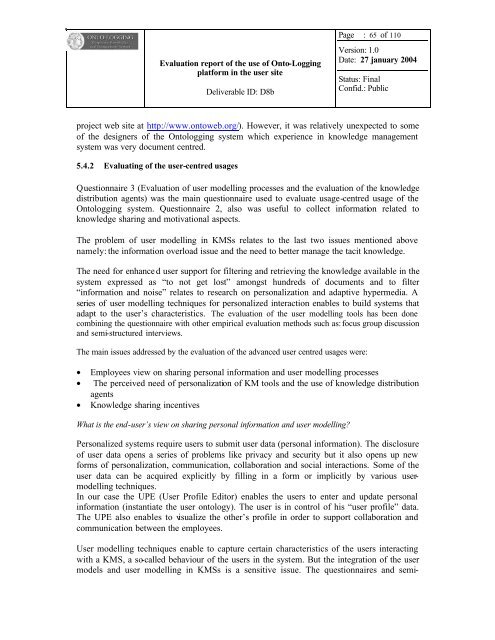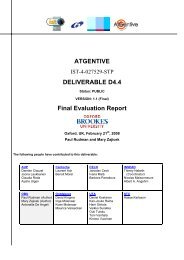pdf 820Kb - INSEAD CALT
pdf 820Kb - INSEAD CALT
pdf 820Kb - INSEAD CALT
You also want an ePaper? Increase the reach of your titles
YUMPU automatically turns print PDFs into web optimized ePapers that Google loves.
Evaluation report of the use of Onto-Logging<br />
platform in the user site<br />
Deliverable ID: D8b<br />
Page : 65 of 110<br />
Version: 1.0<br />
Date: 27 january 2004<br />
Status: Final<br />
Confid.: Public<br />
project web site at http://www.ontoweb.org/). However, it was relatively unexpected to some<br />
of the designers of the Ontologging system which experience in knowledge management<br />
system was very document centred.<br />
5.4.2 Evaluating of the user-centred usages<br />
Questionnaire 3 (Evaluation of user modelling processes and the evaluation of the knowledge<br />
distribution agents) was the main questionnaire used to evaluate usage-centred usage of the<br />
Ontologging system. Questionnaire 2, also was useful to collect information related to<br />
knowledge sharing and motivational aspects.<br />
The problem of user modelling in KMSs relates to the last two issues mentioned above<br />
namely: the information overload issue and the need to better manage the tacit knowledge.<br />
The need for enhance d user support for filtering and retrieving the knowledge available in the<br />
system expressed as “to not get lost” amongst hundreds of documents and to filter<br />
“information and noise” relates to research on personalization and adaptive hypermedia. A<br />
series of user modelling techniques for personalized interaction enables to build systems that<br />
adapt to the user’s characteristics. The evaluation of the user modelling tools has been done<br />
combining the questionnaire with other empirical evaluation methods such as: focus group discussion<br />
and semi-structured interviews.<br />
The main issues addressed by the evaluation of the advanced user centred usages were:<br />
• Employees view on sharing personal information and user modelling processes<br />
• The perceived need of personalization of KM tools and the use of knowledge distribution<br />
agents<br />
• Knowledge sharing incentives<br />
What is the end-user’s view on sharing personal information and user modelling?<br />
Personalized systems require users to submit user data (personal information). The disclosure<br />
of user data opens a series of problems like privacy and security but it also opens up new<br />
forms of personalization, communication, collaboration and social interactions. Some of the<br />
user data can be acquired explicitly by filling in a form or implicitly by various usermodelling<br />
techniques.<br />
In our case the UPE (User Profile Editor) enables the users to enter and update personal<br />
information (instantiate the user ontology). The user is in control of his “user profile” data.<br />
The UPE also enables to visualize the other’s profile in order to support collaboration and<br />
communication between the employees.<br />
User modelling techniques enable to capture certain characteristics of the users interacting<br />
with a KMS, a so-called behaviour of the users in the system. But the integration of the user<br />
models and user modelling in KMSs is a sensitive issue. The questionnaires and semi-
















